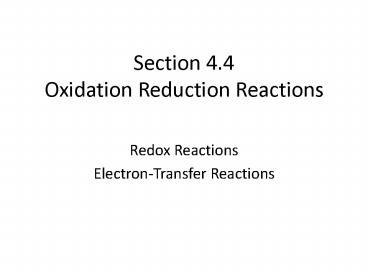Section 4.4 Oxidation Reduction Reactions - PowerPoint PPT Presentation
Title:
Section 4.4 Oxidation Reduction Reactions
Description:
Section 4.4 Oxidation Reduction Reactions Redox Reactions Electron-Transfer Reactions In this section: oxidation and reduction oxidation numbers recognizing redox ... – PowerPoint PPT presentation
Number of Views:20
Avg rating:3.0/5.0
Title: Section 4.4 Oxidation Reduction Reactions
1
Section 4.4 Oxidation Reduction Reactions
- Redox Reactions
- Electron-Transfer Reactions
2
- In this section
- oxidation and reduction
- oxidation numbers
- recognizing redox reactions
- predicting redox reactions
- Not from this section
- a. Organic reactions
3
Oxidation-Reduction Reactions Oxidation loss
of electrons Reduction gain of
electrons Zn(s) Cu2(aq) ? Zn2(aq)
Cu(s) Oxidation Half-Reaction Zn(s) ?
Zn2(aq) 2 e- Reduction Half-Reaction
Cu2(aq) 2 e- ? Cu(s)
4
Oxidation-Reduction Reactions Oxidation loss
of electrons Reduction gain of
electrons Zn(s) Cu2(aq) ? Zn2(aq)
Cu(s) Oxidizing agent oxidant gains
electrons Reducing agent reductant loses
electrons
5
Balancing Simple Redox Reactions
Cu(s) Ag(aq) ? Cu2(aq) 2 Ag(s)
6
Oxidation Numbers
Electron tracking method. Oxidation numbers do
not imply charges.
7
(No Transcript)
8
Examples N in N2 Fe in Fe3 N in NO2- O in
H2O Cl in NaOCl Mn in MnO4-
9
Recognizing Oxidation-Reduction
Reactions Oxidation loss of electrons
increase in ox Reduction gain of electrons
decrease in ox 4 Fe 3 O2 ? 2 Fe2O3
10
CuO(s) H2(g) ? Cu(s) H2O(?) CaCO3(s)
? CaO(s) CO2(g)
11
MnO4-(aq) 5 Fe2(aq) 8 H(aq) ? Mn2(aq) 4
H2O(?) 5 Fe3(aq)
12
Predicting Redox Reactions
13
Organic Reactions
A. Combustion Reactions Reaction with oxygen gas
to form CO2 and H2O. C3H8(g) 5 O2(g) ? 3
CO2(g) 4 H2O(l)
B. Substitution Reactions Exchange of one atom or
molecular fragment.
14
C. Addition Reactions Addition of two molecules
together.
D. Elimination Reactions Ejection of a small
molecule from a larger one.
15
E. Isomerization (Rearrangement) Reactions Change
of shape of a molecule without gain or loss of
any atoms.































